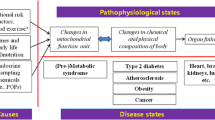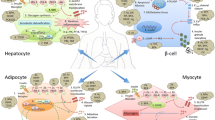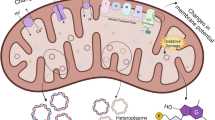Abstract
It is generally accepted that mitochondrial deficits cause many common age-associated diseases including type 2 diabetes. However, it has not been understood what causes mitochondrial damages and how to interrupt the development of the diseases in patients. Recent epidemiologic studies demonstrated a positive correlation between serum concentrations of environmental pollutants and insulin resistance/diabetes. Emerging data strongly suggest that some synthetic pollutants disturb the signaling pathway critical for energy homeostasis and insulin action. The synthetic chemicals are possibly involved in pathogenesis of insulin resistance and diabetes as mitochondria-disturbing agents. In this review, we present a molecular scheme to address the contribution of environmental synthetic chemicals to this metabolic catastrophe. Efforts to identify synthetic chemicals with mitochondria-damaging activities may open a new era to develop effective therapeutic interventions against the worldwide-spreading metabolic disorder.




Similar content being viewed by others
Abbreviations
- T2DM:
-
Type 2 diabetes
- GWAS:
-
Genome-Wide Association Study
- EWAS:
-
Environmental-Wide Association Study
- OR:
-
Odds ratio
- POPs:
-
Persistent organic pollutants
- PCB:
-
Polychlorinated biphenyl
- OC:
-
Organochlorine
- EDC:
-
Endocrine disrupting chemicals
- mtDNA:
-
Mitochondrial DNA
- Ndna:
-
Nuclear DNA
- OXPHOS:
-
Oxidative phosphorylation
- AhR:
-
Aryl hydrocarbon receptor
- AhRR:
-
AhR repressor
- TCDD:
-
2,3,7,8-tetrachlorodibenzo-p-dioxin
- ROS:
-
Reactive oxygen species
- FICZ:
-
6-formylindolo[3,2-b]carbazole
- MPP+ :
-
1-methyl-4-phenylpyridinium
- PD:
-
Parkinson’s disease
- CMAPS:
-
Cell-based mitochondrial activity profiling assays
References
Ahn, S.Y., Y.S. Choi, H.J. Koo, J.H. Jeong, W.H. Park, M. Kim, Y. Piao, and Y.K. Pak. 2010. Mitochondrial dysfunction enhances the migration of vascular smooth muscles cells via suppression of Akt phosphorylation. Biochimica et Biophysica Acta 1800: 275–281.
Beischlag, T.V., J. Luis Morales, B.D. Hollingshead, and G.H. Perdew. 2008. The aryl hydrocarbon receptor complex and the control of gene expression. Critical Reviews in Eukaryotic Gene Expression 18: 207–250.
Beischlag, T.V., S. Wang, D.W. Rose, J. Torchia, S. Reisz-Porszasz, K. Muhammad, W.E. Nelson, M.R. Probst, M.G. Rosenfeld, and O. Hankinson. 2002. Recruitment of the NCoA/SRC-1/p160 family of transcriptional coactivators by the aryl hydrocarbon receptor/aryl hydrocarbon receptor nuclear translocator complex. Molecular and Cellular Biology 22: 4319–4333.
Camacho, I.A., N. Singh, V.L. Hegde, M. Nagarkatti, and P.S. Nagarkatti. 2005. Treatment of mice with 2,3,7,8-tetrachlorodibenzo-p-dioxin leads to aryl hydrocarbon receptor-dependent nuclear translocation of NF-kappaB and expression of Fas ligand in thymic stromal cells and consequent apoptosis in T cells. Journal of Immunology 175: 90–103.
Chen, Q., N.N. Huang, J.T. Huang, S. Chen, J. Fan, C. Li, and F.K. Xie. 2009. Sodium benzoate exposure downregulates the expression of tyrosine hydroxylase and dopamine transporter in dopaminergic neurons in developing zebrafish. Birth Defects Research Part B, Developmental and Reproductive Toxicology 86: 85–91.
Chen, S.C., T.L. Liao, Y.H. Wei, C.R. Tzeng, and S.H. Kao. 2010. Endocrine disruptor, dioxin (TCDD)-induced mitochondrial dysfunction and apoptosis in human trophoblast-like JAR cells. Molecular Human Reproduction 16: 361–372.
Choi, Y.S., J.H. Jeong, H.K. Min, H.J. Jung, D. Hwang, S.W. Lee, and Y.K. Pak. 2011. Shot-gun proteomic analysis of mitochondrial D-loop DNA binding proteins: Identification of mitochondrial histones. Molecular BioSystems 7: 1523–1536.
Denison, M.S., A. Pandini, S.R. Nagy, E.P. Baldwin, and L. Bonati. 2002. Ligand binding and activation of the Ah receptor. Chemico-Biological Interactions 141: 3–24.
Denison, M.S., A.A. Soshilov, G. He, D.E. Degroot, and B. Zhao. 2011. Exactly the same but different: Promiscuity and diversity in the molecular mechanisms of action of the aryl hydrocarbon (dioxin) receptor. Toxicological Sciences 124: 1–22.
Dimauro, S., and E.A. Schon. 2003. Mitochondrial respiratory-chain diseases. New England Journal of Medicine 348: 2656–2668.
Evans, B.R., S.I. Karchner, L.L. Allan, R.S. Pollenz, R.L. Tanguay, M.J. Jenny, D.H. Sherr, and M.E. Hahn. 2008. Repression of aryl hydrocarbon receptor (AHR) signaling by AHR repressor: role of DNA binding and competition for AHR nuclear translocator. Molecular Pharmacology 73: 387–398.
Forgacs, A.L., L.D. Burgoon, S.G. Lynn, J.J. Lapres, and T. Zacharewski. 2010. Effects of TCDD on the expression of nuclear encoded mitochondrial genes. Toxicology and Applied Pharmacology 246: 58–65.
Hong, N.S., K.S. Kim, I.K. Lee, P.M. Lind, L. Lind, D.R. Jacobs, and D.H. Lee. 2012. The association between obesity and mortality in the elderly differs by serum concentrations of persistent organic pollutants: A possible explanation for the obesity paradox. International Journal of Obesity (Lond) 36: 1170–1175.
Jonietz, E. 2012. Pathology: Cause and effect. Nature 485: S10–S11.
Kiss, E.A., C. Vonarbourg, S. Kopfmann, E. Hobeika, D. Finke, C. Esser, and A. Diefenbach. 2011. Natural aryl hydrocarbon receptor ligands control organogenesis of intestinal lymphoid follicles. Science 334: 1561–1565.
Lane, N. 2006. Mitochondrial disease: Powerhouse of disease. Nature 440: 600–602.
Larsen, N.B., M. Rasmussen, and L.J. Rasmussen. 2005. Nuclear and mitochondrial DNA repair: Similar pathways? Mitochondrion 5: 89–108.
Lee, C.S., H.H. Ko, J.H. Song, and E.S. Han. 2002. Effect of R-(−)-deprenyl and harmaline on dopamine- and peroxynitrite-induced membrane permeability transition in brain mitochondria. Neurochemical Research 27: 215–224.
Lee, D.H., I.K. Lee, K. Song, M. Steffes, W. Toscano, B.A. Baker, and D.R. Jacobs Jr. 2006. A strong dose-response relation between serum concentrations of persistent organic pollutants and diabetes: Results from the National Health and Examination Survey 1999–2002. Diabetes Care 29: 1638–1644.
Lee, D.H., L. Lind, D.R. Jacobs Jr, S. Salihovic, B. Van Bavel, and P.M. Lind. 2012. Associations of persistent organic pollutants with abdominal obesity in the elderly: The Prospective Investigation of the Vasculature in Uppsala Seniors (PIVUS) study. Environment International 40: 170–178.
Lee, D.H., M.W. Steffes, A. Sjodin, R.S. Jones, L.L. Needham, and D.R. Jacobs Jr. 2011. Low dose organochlorine pesticides and polychlorinated biphenyls predict obesity, dyslipidemia, and insulin resistance among people free of diabetes. PLoS ONE 6: e15977.
Li, Y., S. Innocentin, D.R. Withers, N.A. Roberts, A.R. Gallagher, E.F. Grigorieva, C. Wilhelm, and M. Veldhoen. 2011. Exogenous stimuli maintain intraepithelial lymphocytes via aryl hydrocarbon receptor activation. Cell 147: 629–640.
Lim, S., S.Y. Ahn, I.C. Song, M.H. Chung, H.C. Jang, K.S. Park, K.U. Lee, Y.K. Pak, and H.K. Lee. 2009. Chronic exposure to the herbicide, atrazine, causes mitochondrial dysfunction and insulin resistance. PLoS ONE 4: e5186.
Murphy, M.P., M.J. Krueger, S.O. Sablin, R.R. Ramsay, and T.P. Singer. 1995. Inhibition of complex I by hydrophobic analogues of N-methyl-4-phenylpyridinium (MPP+) and the use of an ion-selective electrode to measure their accumulation by mitochondria and electron-transport particles. The Biochemical Journal 306(Pt 2): 359–365.
Neel, B.A., and R.M. Sargis. 2011. The paradox of progress: Environmental disruption of metabolism and the diabetes epidemic. Diabetes 60: 1838–1848.
Neri, T., V. Merico, F. Fiordaliso, M. Salio, P. Rebuzzini, L. Sacchi, R. Bellazzi, C.A. Redi, M. Zuccotti, and S. Garagna. 2011. The differentiation of cardiomyocytes from mouse embryonic stem cells is altered by dioxin. Toxicology Letters 202: 226–236.
Nicklas, W.J., I. Vyas, and R.E. Heikkila. 1985. Inhibition of NADH-linked oxidation in brain mitochondria by 1-methyl-4-phenyl-pyridine, a metabolite of the neurotoxin, 1-methyl-4-phenyl-1,2,5,6-tetrahydropyridine. Life Sciences 36: 2503–2508.
Opitz, C.A., U.M. Litzenburger, F. Sahm, M. Ott, I. Tritschler, S. Trump, T. Schumacher, L. Jestaedt, D. Schrenk, M. Weller, M. Jugold, G.J. Guillemin, C.L. Miller, C. Lutz, B. Radlwimmer, I. Lehmann, A. Von Deimling, W. Wick, and M. Platten. 2011. An endogenous tumour-promoting ligand of the human aryl hydrocarbon receptor. Nature 478: 197–203.
Pak, Y.K., and J.H. Jeong. 2010. Mitochondria: The secret chamber of therapeutic targets for age-associated degenerative diseases. Biomolecules & Therapeutics 18: 235–245.
Patel, C.J., J. Bhattacharya, and A.J. Butte. 2010. An Environment-Wide Association Study (EWAS) on type 2 diabetes mellitus. PLoS ONE 5: e10746.
Piao, Y., H.G. Kim, M.S. Oh, and Y.K. Pak. 2012. Overexpression of TFAM, NRF-1 and myr-AKT protects the MPP(+)-induced mitochondrial dysfunctions in neuronal cells. Biochimica et Biophysica Acta 1820: 577–585.
Piper, P.W. 1999. Yeast superoxide dismutase mutants reveal a pro-oxidant action of weak organic acid food preservatives. Free Radical Biology & Medicine 27: 1219–1227.
Ruzzin, J., R. Petersen, E. Meugnier, L. Madsen, E.J. Lock, H. Lillefosse, T. Ma, S. Pesenti, S.B. Sonne, T.T. Marstrand, M.K. Malde, Z.Y. Du, C. Chavey, L. Fajas, A.K. Lundebye, C.L. Brand, H. Vidal, K. Kristiansen, and L. Froyland. 2010. Persistent organic pollutant exposure leads to insulin resistance syndrome. Environmental Health Perspectives 118: 465–471.
Sarioglu, H., S. Brandner, M. Haberger, C. Jacobsen, J. Lichtmannegger, M. Wormke, and U. Andrae. 2008. Analysis of 2,3,7,8-tetrachlorodibenzo-p-dioxin-induced proteome changes in 5L rat hepatoma cells reveals novel targets of dioxin action including the mitochondrial apoptosis regulator VDAC2. Molecular and Cellular Proteomics 7: 394–410.
Schlezinger, J.J., P.L. Bernard, A. Haas, P. Grandjean, P. Weihe, and D.H. Sherr. 2010. Direct assessment of cumulative aryl hydrocarbon receptor agonist activity in sera from experimentally exposed mice and environmentally exposed humans. Environmental Health Perspectives 118: 693–698.
Senft, A.P., T.P. Dalton, D.W. Nebert, M.B. Genter, A. Puga, R.J. Hutchinson, J.K. Kerzee, S. Uno, and H.G. Shertzer. 2002. Mitochondrial reactive oxygen production is dependent on the aromatic hydrocarbon receptor. Free Radical Biology and Medicine 33: 1268–1278.
Shen, D., T.P. Dalton, D.W. Nebert, and H.G. Shertzer. 2005. Glutathione redox state regulates mitochondrial reactive oxygen production. Journal of Biological Chemistry 280: 25305–25312.
Shetty, P.V., B.Y. Bhagwat, and W.K. Chan. 2003. P23 enhances the formation of the aryl hydrocarbon receptor–DNA complex. Biochemical Pharmacology 65: 941–948.
Storch, A., Y.I. Hwang, D.A. Gearhart, J.W. Beach, E.J. Neafsey, M.A. Collins, and J. Schwarz. 2004. Dopamine transporter-mediated cytotoxicity of beta-carbolinium derivatives related to Parkinson’s disease: Relationship to transporter-dependent uptake. Journal of Neurochemistry 89: 685–694.
Tanaka, T., A. Morita, M. Kato, T. Hirai, T. Mizoue, Y. Terauchi, S. Watanabe, and M. Noda. 2011. Congener-specific polychlorinated biphenyls and the prevalence of diabetes in the Saku Control Obesity Program (SCOP). Endocrine Journal 58: 589–596.
Tappenden, D.M., S.G. Lynn, R.B. Crawford, K. Lee, A. Vengellur, N.E. Kaminski, R.S. Thomas, and J.J. Lapres. 2011. The aryl hydrocarbon receptor interacts with ATP5alpha1, a subunit of the ATP synthase complex, and modulates mitochondrial function. Toxicology and Applied Pharmacology 254: 299–310.
Tariq, M., M. Arshaduddin, N. Biary, K. Al Moutaery, and S. Al Deeb. 2002. 2-Deoxy-d-glucose attenuates harmaline induced tremors in rats. Brain Research 945: 212–218.
Tian, Y., A.B. Rabson, and M.A. Gallo. 2002. Ah receptor and NF-kappaB interactions: Mechanisms and physiological implications. Chemico-Biological Interactions 141: 97–115.
Tsay, H.J., Y.H. Wang, W.L. Chen, M.Y. Huang, and Y.H. Chen. 2007. Treatment with sodium benzoate leads to malformation of zebrafish larvae. Neurotoxicology and Teratology 29: 562–569.
Wagner, B.K., T.J. Gilbert, J. Hanai, S. Imamura, N.E. Bodycombe, R.S. Bon, H. Waldmann, P.A. Clemons, V.P. Sukhatme, and V.K. Mootha. 2011. A small-molecule screening strategy to identify suppressors of statin myopathy. ACS Chemical Biology 6: 900–904.
Wagner, B.K., T. Kitami, T.J. Gilbert, D. Peck, A. Ramanathan, S.L. Schreiber, T.R. Golub, and V.K. Mootha. 2008. Large-scale chemical dissection of mitochondrial function. Nature Biotechnology 26: 343–351.
Wild, S., G. Roglic, A. Green, R. Sicree, and H. King. 2004. Global prevalence of diabetes: estimates for the year 2000 and projections for 2030. Diabetes Care 27: 1047–1053.
Wincent, E., J. Bengtsson, A. Mohammadi Bardbori, T. Alsberg, S. Luecke, U. Rannug, and A. Rannug. 2012. Inhibition of cytochrome P4501-dependent clearance of the endogenous agonist FICZ as a mechanism for activation of the aryl hydrocarbon receptor. Proceedings of the National Academy of Sciences of the Unites States of America 109: 4479–4484.
Zudaire, E., N. Cuesta, V. Murty, K. Woodson, L. Adams, N. Gonzalez, A. Martinez, G. Narayan, I. Kirsch, W. Franklin, F. Hirsch, M. Birrer, and F. Cuttitta. 2008. The aryl hydrocarbon receptor repressor is a putative tumor suppressor gene in multiple human cancers. Journal of Clinical Investigation 118: 640–650.
Acknowledgment
This study was supported by NRF grant funded by the Korean Ministry of Education, Science, and Technology (20120001162) and by a grant of the Korean Health Technology R&D Project, Ministry of Health & Welfare (B12002912010000100). The funding source was not involved in study design; collection, analysis and interpretation of data; the writing of the manuscript; the decision to submit the manuscript for publication.
Author information
Authors and Affiliations
Corresponding author
Rights and permissions
About this article
Cite this article
Park, WH., Kang, YC., Piao, Y. et al. Causal effects of synthetic chemicals on mitochondrial deficits and diabetes pandemic. Arch. Pharm. Res. 36, 178–188 (2013). https://doi.org/10.1007/s12272-013-0022-9
Received:
Accepted:
Published:
Issue Date:
DOI: https://doi.org/10.1007/s12272-013-0022-9




